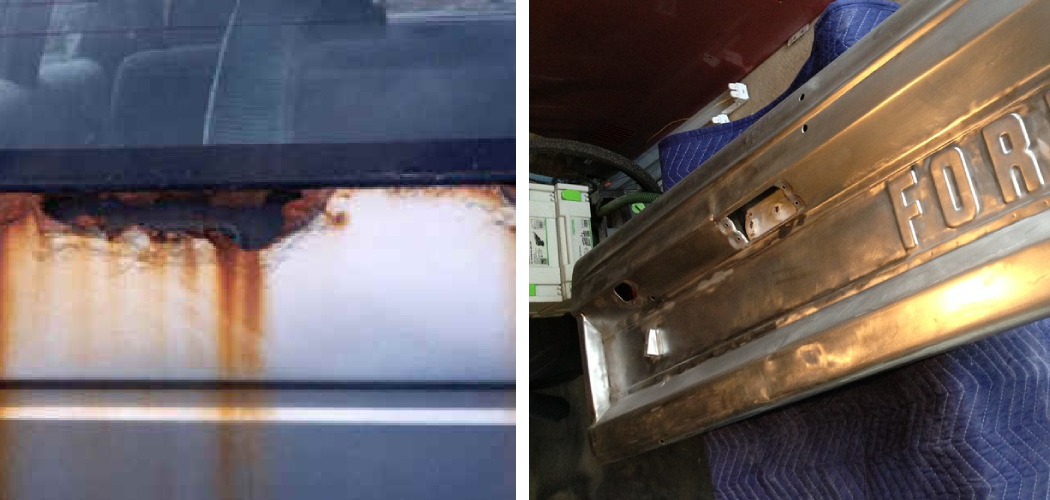The Jeep tailgate stands as a symbol of freedom and adventure, integral to the vehicle’s iconic design. Yet, this treasured feature is not immune to the relentless forces of nature; rust is a persistent foe that threatens to undermine the tailgate’s integrity.

Understanding how to prevent tailgate rust is key to maintaining your Jeep’s value, appearance, and rugged functionality. In this article, we explore a spectrum of strategies, from simple preventive measures to robust professional treatments, ensuring that Jeep enthusiasts have the knowledge to protect their beloved vehicles against various degrees of corrosion.
Understanding the Causes of Tailgate Rust
Rust formation on tailgates primarily stems from persistent exposure to the elements. Water, as a catalyst for corrosion, particularly when compounded with road salt, dramatically speeds up the rusting process. Salt, used for deicing roads, is an aggressive corrosive agent that can swiftly eat away at the tailgate’s protective coatings and metal. Yet, there are other exacerbating factors to consider.
Age and Wear:
Over time, tailgates bear the brunt of innumerable journeys, which can lead to chipped paint or scratches— prime spots for rust to take hold.
Location:
Vehicles operated in areas with high humidity or where roads are frequently treated with salt due to snow stand at an increased risk of developing rust.
Damage:
Tailgates with dents, scrapes, or cracks can also become havens for trapped moisture and debris, creating an ideal environment for rust proliferation. Understanding these catalysts is crucial in selecting the right preventive measures, as it enables Jeep owners to tackle the root causes of corrosion, ensuring long-lasting protection and the enduring allure of their tailgates.
How to Prevent Tailgate Rust: A Comprehensive Guide
1. Assessing Your Tailgate’s Condition
Before any rust prevention or treatment can be initiated, a thorough assessment of your Jeep’s tailgate is imperative. Start with a visual inspection in a well-lit environment, searching for the tell-tale signs of surface rust, such as discoloration, blisters, or peeling paint, which are often early indicators of corrosion. Run your hand along the tailgate’s surface; any roughness could signify rust forming beneath the paint.
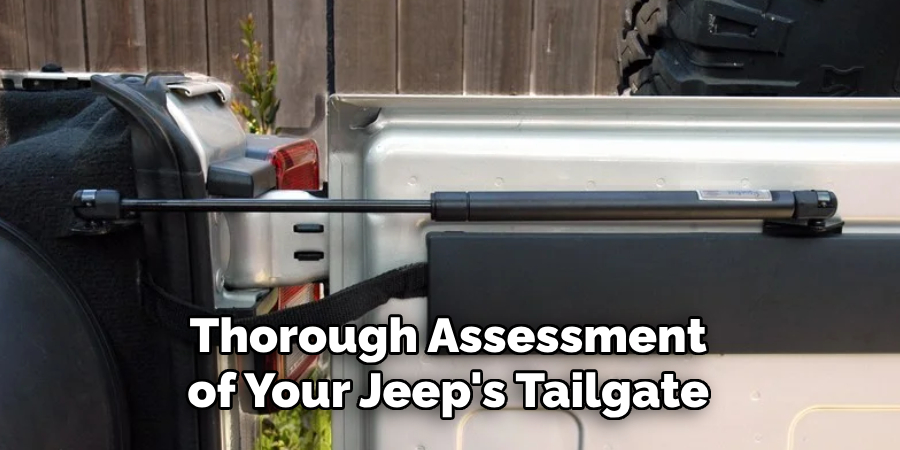
Equipped with a screwdriver, gently tap distinct areas of the tailgate. A solid sound indicates healthy metal, whereas a hollow sound might indicate deeper rust, compromising the integrity of the metal. It’s crucial to inspect areas beneath weatherstripping and around hinges; these hidden spots frequently harbor unnoticed rust.
Categorize the rust’s severity: surface rust is generally manageable through DIY methods, moderate rust may require more extensive procedures like sanding and priming, and advanced rust, often signaled by metal perforation, typically necessitates professional intervention. For Jeep owners discovering significant rust damage, seeking a professional’s skills to address complex issues effectively and ensure the tailgate’s longevity and functionality is advisable.
2. Preventive Measures for New or Lightly Rusted Tailgates
The best offense against tailgate rust is a strong defense; initiating preventive measures is essential, particularly for new or lightly rusted tailgates. The first step in this defensive strategy is regular washing and drying.
Removing accumulated dirt, salt, and moisture diminishes the chances of rust taking hold. Pay special attention to the undercarriage and hidden crevices where contaminants tend to collect.
Once the tailgate is clean, applying a high-quality wax or sealant can provide a protective barrier against the elements. Products that offer UV protection are particularly beneficial, as they guard against rust and the sun’s fading effects.
For minor scratches or chips, applying touch-up paint promptly is prudent. This maintains the vehicle’s aesthetic appeal and, more importantly, prevents these vulnerabilities from becoming rust’s entry points.

Garage storage can vastly reduce the tailgate’s exposure to adverse weather conditions. When a garage isn’t available, consider using a breathable, weatherproof car cover to shield your Jeep from moisture and pollutants. For added security, rust inhibitor sprays can be regularly applied to metallic surfaces, hindering oxidation.
It’s also worth noting that during winter, when road salt is prevalent, increasing the frequency of maintenance routines can significantly contribute to keeping rust at bay. While they require investment in time and resources, these proactive steps pay dividends in extending the tailgate’s pristine condition and service life, allowing you to enjoy the iconic capabilities of your Jeep without the looming threat of corrosion.
3. Addressing Surface Rust Yourself
When faced with the initial stages of rust on your Jeep’s tailgate, it’s crucial to act swiftly to prevent spreading. Addressing surface rust can be a manageable task if approached methodically and with the right materials at hand.
Begin by gathering essential items: fine-grit sandpaper, a quality rust remover, masking tape, a dependable rust-inhibiting primer, and touch-up paint that matches your vehicle’s color.
Start the process by gently sanding down the affected area to remove any loose rust particles and flaking paint; this will expose the bare metal necessary for effective treatment. Always sand in the direction of the grain to avoid additional scratching of the surrounding surfaces.
Applying the rust remover according to the product’s instructions once the area is sanded to a smooth, clean finish. Safety note: ensure you work in a well-ventilated space and use protective gloves and eyewear. The chemical will react with the rust, preparing the metal for priming.
The next step involves masking the areas around the rust spot to protect them from overspray or accidental primer and paint application. When everything is securely masked, apply the primer, which will provide a layer of protection against future corrosion and help the touch-up paint adhere better. Allow the primer to dry completely, observing the manufacturer’s recommended drying times.
Finally, apply the touch-up paint in light, even layers. It may take several coats to build up the paint to the rest of the surrounding area’s level. Each coat should be allowed to dry before adding another. When applying touch-up paint, patience is your ally; rushing can lead to a patchy or uneven finish. Once complete, a final layer of wax or sealant can enhance the protection of the newly treated area.
4. Professional Rust Repair for Advanced Cases
When dealing with deep rust or extensive damage where DIY methods are no longer viable, seeking professional help is critical to preserving the integrity of your Jeep’s tailgate.

For owners who lack the experience or tools required for intensive rust remediation, professionals can offer a wide range of services, including sandblasting, which effectively removes rust and old paint by propelling abrasive material against the metal surface under high pressure.
Skilled technicians can also perform welding repairs for areas where rust has perforated the metal. They ensure that new metal is seamlessly integrated with the existing structure. Additionally, professional body shops have the expertise to precisely match your vehicle’s paint, ensuring that any repairs blend indistinguishably with the original finish — a nuanced task often outside the capability of most DIY enthusiasts.
Cost is an important consideration when opting for professional rust repair services. While it can be significant, the investment safeguards against further damage and preserves the vehicle’s value. It’s advisable to obtain quotes from reputable body shops, considering their experience and any quality guarantees they offer.
This ensures that you choose a service that provides the best balance of cost and quality, maintaining your Jeep’s rugged good looks and readiness for off-road adventures.
That’s it! You’ve now learned how to prevent tailgate rust, address surface rust on your own, and when it’s time to seek professional help. By taking proactive measures and promptly addressing rust, you can keep your Jeep looking its best and ready for any adventure. So get out there and enjoy all the possibilities of owning a rugged and durable Jeep without the worry of rust hindering your fun!
Undercoating and Additional Protection
Advances in rust prevention methods offer Jeep owners robust solutions to shield their vehicles from the relentless assault of corrosion. Undercoating is a process typically performed by professionals that involves applying a thick, protective coating to the underbelly of a vehicle.
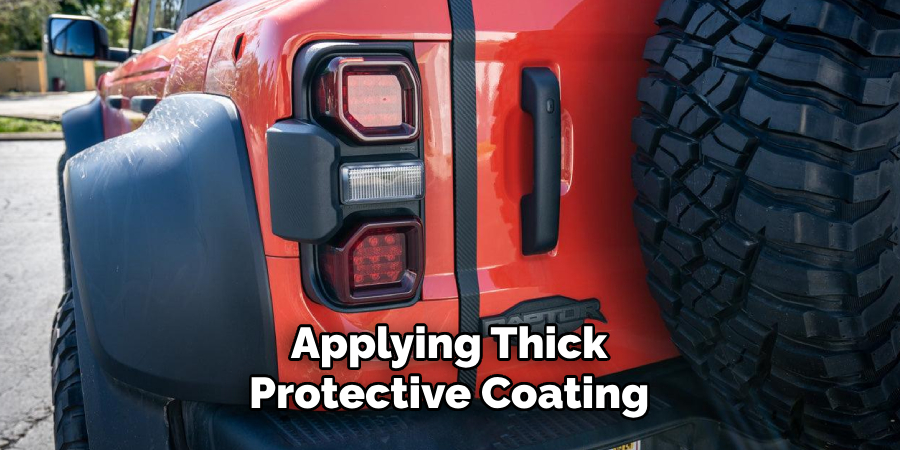
Not only does this provide an extra layer of protection against debris, but it also creates a barrier against moisture and salt—one of the rust’s chief allies—particularly advantageous for Jeeps navigating harsh environments.
Various undercoating materials are available, such as rubberized coatings, which offer flexible, durable, barrier, and polyurethane-based options, known for their longevity and strength. However, these protective layers are not without their drawbacks. The added weight from the undercoating might insignificantly affect a vehicle’s fuel efficiency, and some types may require periodic reapplication to maintain their protective properties.
For Jeep enthusiasts interested in a more hands-on approach, DIY spray-on undercoating solutions can be cost-effective alternatives. These aerosol or paintable coatings allow for personalized application focus, particularly on high-risk areas prone to rust.
Choosing the right product and following proper application procedures are critical—this ensures the undercoating adhere correctly and avoids trapping moisture against the metal, which could inadvertently expedite the rusting process.
While professional undercoating services ensure precise application and often come with quality guarantees, DIY solutions provide satisfactory protection for those willing to invest personal time and labor. Both methods underscore the vital role of proactive, preventative maintenance in preserving a Jeep’s resilience and aesthetics.
Tailgate-Specific Protection and Accessories
Several tailgate-specific protection measures are essential for those aiming to enhance their Jeep’s tailgate durability. First, quality tailgate sealants can greatly hinder rust development around the hinges and weatherstripping areas, which are particularly susceptible to moisture infiltration. Brands like 3M and Permatex are renowned for their automotive sealants that effectively seal out moisture and protect against the elements.
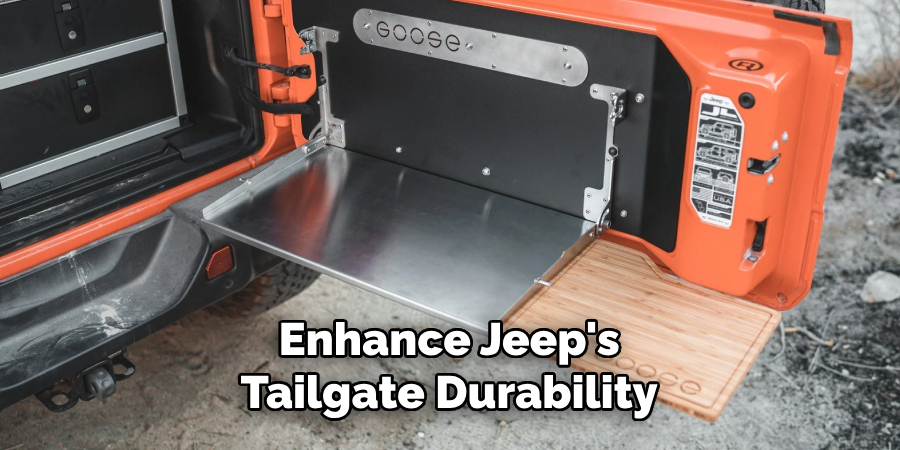
Mud flaps, like those from WeatherTech, also play a pivotal role; minimizing the spray of salt and debris onto the tailgate area adds a crucial defense against corrosion. Another integral accessory comes in the form of cargo mats. BedRug, for example, offers cargo mats that protect the bed floor from damage and keep it dry, preventing rusting that can occur due to moisture trapped under the cargo.
Lastly, tailgate covers, such as the ones from TruXedo, can provide an extra layer of weather protection. Notably, these covers are designed to shield against prolonged exposure to rain and snow, which can significantly deter rust formation.
Jeep owners should prioritize compatibility with their specific model when selecting these products to ensure maximum effectiveness in warding off rust and maintaining the vehicle’s aesthetic and structural integrity.
Long-Term Maintenance and Monitoring
Long-term maintenance and routine monitoring are fundamental in the battle against rust, especially for critical components like a Jeep’s tailgate. Regular washing and drying become paramount, particularly after driving through harsh conditions that can leave behind corrosive agents such as road salt and mud. It is essential to remove these elements promptly, as they can accelerate the oxidation process and compromise the integrity of the vehicle’s metal.
Frequent re-application of wax or sealant is also advised to maintain a strong protective barrier. These products act like a shield, repelling water and contaminants that may otherwise cling to the vehicle’s surface. With time, the efficacy of these barriers can diminish, so it’s important to reapply them according to the manufacturer’s recommendations or at least twice a year.

Owners should make it a habit to inspect the tailgate for new rust spots and address them immediately. The sooner these areas are identified and treated, the less likely they will evolve into larger, more problematic corrosion issues. Additionally, minor scratches or paint chips should be touched quickly to prevent rust from taking hold.
Considering professional inspections is worthwhile for those living in climates with extreme weather conditions or who frequently use their vehicle in challenging environments. A qualified technician can assess the undercoating’s condition and reapply it as needed, ensuring continuous and reliable protection.
These professional assessments can catch potential vulnerabilities before they blossom into significant rust problems, thereby preserving the vehicle’s aesthetic and overall longevity and resale value.
Restoring a Rusted Tailgate
When faced with a heavily rusted Jeep tailgate, restoration is possible through dedicated DIY effort and acquired skill. The process is labor-intensive, beginning with the arduous task of sanding down the rusted areas to bare metal.
Specialized tools such as sanders, grinders, and possibly chemical rust removers are vital to thoroughly eliminate all traces of corrosion. Following rust removal, bodywork repairs may be necessary, including filling in holes or dents with body filler and ensuring everything is smoothed out for the primer and paint to adhere properly.
The repainting phase involves meticulously applying primer, paint, and clear coat, replicating the factory finish as closely as possible. The time commitment for such a project can span several days, factoring in drying and curing times. Successful restoration requires time, a comprehensive set of tools, and a high level of expertise to avoid common pitfalls such as uneven paint application or missed corrosion spots.
For those unsure about tackling such a complex project, it is prudent to seek professional help. However, experienced DIY enthusiasts can find many resources, including detailed restoration guides and video tutorials, that provide step-by-step instructions for restoring a rusted tailgate to its former glory.
Frequently Asked Questions About Jeep Tailgate Rust Protection and Restoration
Q: How Often Should I Apply Wax or Sealant to My Jeep Tailgate for Rust Protection?
A: It is recommended to reapply wax or sealant to your Jeep tailgate at least twice a year or according to the manufacturer’s recommendations. This frequency should increase if you often drive through harsh conditions with road salt and mud.
Q: Can a Diy Undercoating Job Provide the Same Level of Protection as Professional Services?
A: DIY undercoating can provide satisfactory protection if applied correctly; however, professional services usually offer a more precise application and may come with quality guarantees.
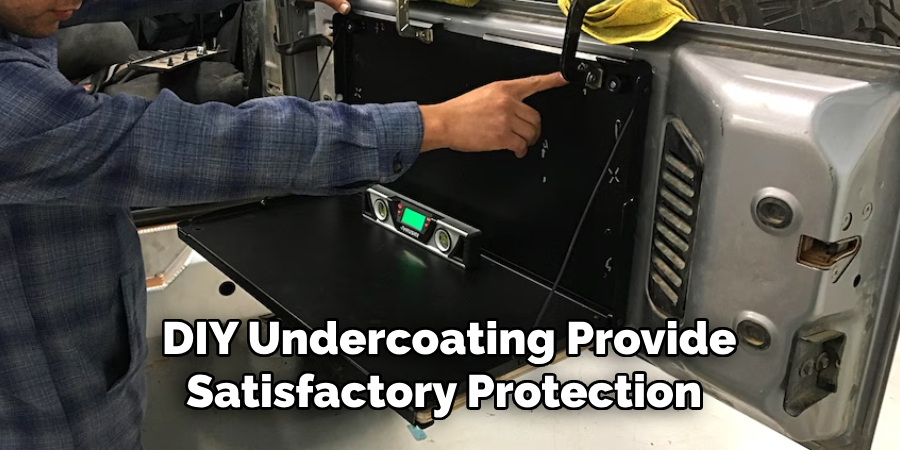
Q: What Should I Do When I Discover a New Rust Spot on My Tailgate?
A: New rust spots should be addressed immediately. Clean the area thoroughly, remove the rust, apply a rust-preventive primer, and then repaint the spot to prevent future corrosion.
Q: Are Tailgate-Specific Accessories Really Necessary for Protecting Against Rust?
A: Yes, accessories like quality sealants, mud flaps, cargo mats, and tailgate covers can provide additional layers of protection against rust by sealing out moisture and minimizing the spray of salt and debris onto the tailgate area.
Q: Is It Worth Getting Professional Inspections Even if I Regularly Maintain My Jeep?
A: Professional inspections can be very beneficial for those living in climates with severe weather or who frequently drive in challenging conditions. These can help assess the condition of your undercoating and catch potential issues before they become significant rust problems.
Q: What Tools Do I Need to Restore a Rusted Tailgate on My Own?
A: For DIY rusted tailgate restoration, you’ll need sanders or grinders, chemical rust removers, body filler, primer, paint, and clear coat, among other tools. Ensure you have a good understanding and the necessary skills to complete the project or consult a professional.
Q: Can Scratches and Chips in The Tailgate Paint Lead to Rust?
A: Yes, even minor scratches and chips can expose the metal and lead to rust if left untreated. It’s important to touch them up promptly with the right paint and protective coatings.
Conclusion
In summary, a comprehensive strategy combining regular maintenance, use of protective accessories, and meticulous monitoring is crucial in learning how to prevent tailgate rust. Harnessing both professional services and DIY methods, Jeep owners can cover all bases—from undercoating to sealant application—to shield their tailgates effectively.
Whether tackling restoration independently or seeking expert assistance, the key is to remain proactive, leveraging the guidance provided. We appreciate your attention to the finer details of tailgate care and invite continued dialogue on preventive measures for specific Jeep models. May your adventures be many, and your Jeep’s tailgate remains steadfast against rust.

